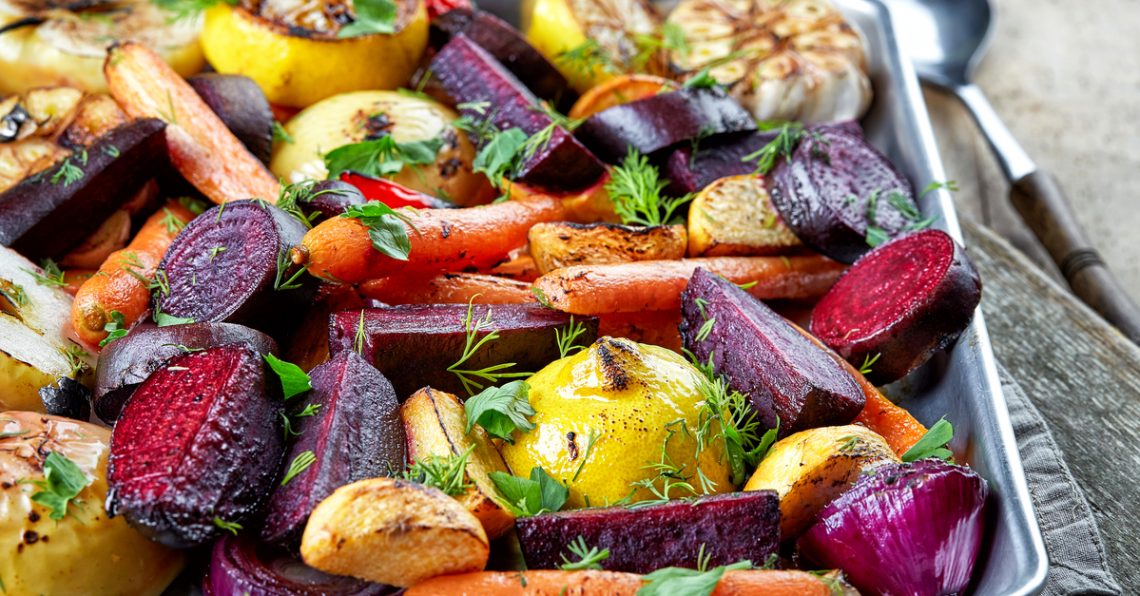
Warm Up the Kitchen with a Vegetable Roast
Looking for a healthful meal that’s simple, relatively fast, and doesn’t require a lot of clean-up? How about trying roasted vegetables? With a little creativity, you can put together your own family recipes that are easy to repeat. And perhaps you can use up some of that extra stuff in your crisper drawer.
Here’s the easy part. Once you understand the basics of how a good vegetable roast works, you can substitute and create new options, based on what’s fresh and available at your local vegetable stand or supermarket. Just pick good-looking vegetables that you think will pair well together once roasted. Think not only flavor, but texture differences and different colors to provide visual appeal.
The basic approach involves washing and drying the vegetables; cutting them into bite-size pieces (not too big, not too small); tossing them in a good-quality oil (preferably olive oil); sprinkling on salt and pepper and your favored seasoning; and spreading them out on a sheet pan. Pop them into a hot oven, and when the roasting is done, dinner’s ready.
Make it a meal
A key tip for success as you’re planning your meal: Various vegetables roast at different times.
- Root vegetables (potatoes, carrots, parsnips, beets): 30-45 minutes.
- Winter squashes (pumpkins, butternut squash, kabocha): 20-60 minutes depending on the size of the pieces.
- Cruciferous vegetables (cauliflower, broccoli/brussels sprouts): 15-30 minutes
- Summer squash/bok choy/peppers and eggplants: 10-20 minutes
- Finger-sized vegetables (asparagus, green beans, scallions, broccolini): 10-20 minutes
- Onions: 30-45 minutes
- Tomatoes: 15-20 minutes
Here are more details for your recipe.
- Preheat your oven to 425 degrees. The ideal temperature for roasting vegetables is 400-450 degrees.
- Wash your vegetables and dry them. Cut them into bite-size pieces and place them in a large bowl for mixing. Add olive oil (start with 2 tablespoons) and salt and pepper. The salt pulls out the moisture and helps the vegetables to caramelize. Add any additional herbs and spices for flavoring, then toss the vegetables by hand to make sure that they’re all coated with oil. Add more, if necessary, but don’t leave any oil in the bottom of the bowl.
- Cover a sheet pan with foil and spread out your vegetables in a single layer. Make sure that the pieces are separated. Crowded vegetables steam rather than roast.
- Start with the vegetables that take longest to roast or pair vegetables with the same roasting times.
- Roast different cooking-time vegetables in stages or in separate pans. (Add the shorter-cooking-time vegetables later.) Roast until fork tender, and remember that larger pieces take longer than small ones. To be safe, taste one of the larger pieces. You want them bite tender with a little bit of char.
- Enjoy the delicious aromas wafting through the kitchen and serve.
Make it delicious
You can also think about pairings or add-ins for your vegetables dish. Here’s where you can elevate your dish from so-so to “wow.” Think colors, flavors (sweet/sour/savory), variety, crunch.
- 10 minutes prior to completion, add a can of rinsed and drained kidney beans, chickpeas, or lentils.
- Serve over farro, quinoa, or rice.
- Mix in melted butter, brown butter, or other flavored butter or oil before serving.
- Cover with chopped toasted almonds, walnuts, pecans, peanuts, or whatever you have on hand.
- Toss in pomegranate seeds, sautéed apples or pears, dried cranberries, or currants.
- After roasting, sprinkle on toasted sesame seeds or pepitas (toasted pumpkin seeds).
- Top with feta, Provolone, goat cheese, or grated Parmesan or cheddar cheese, chopped fried bacon or pancetta.
- Serve with fried or chopped hard-boiled eggs.
- Braise some mushrooms to serve on the side.
- Or make the roasted vegetables part of an antipasto plate.
I’m sure that you can experiment to find a few inspiring dishes – and not just the obvious Italian roasted vegetables or Spanish escalivada. How about carrots with harissa or miso butter or butternut squash with dried cranberries? Or try roasted eggplant and barley salad, Buffalo wings–flavored roasted cauliflower, or broccolini and green beans with wine-based mushrooms … The possibilities are endless. Let us know what you’ve concocted.
To comment, please click on “Read in Browser” or on the headline to view the blog on the website. You can log in and comment at the end of the blog to share your thoughts and start a discussion.
If you’d like to share the blog, click on the Facebook icon or one of the others. Thanks!





One Comment
Susan
Good reminders while stuck in the mid-winter cooking boredom.
I especially like the recommended pairings. Thanks!